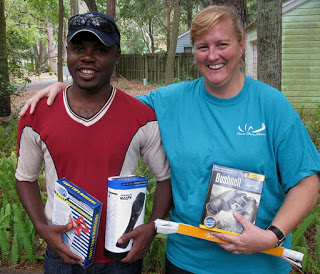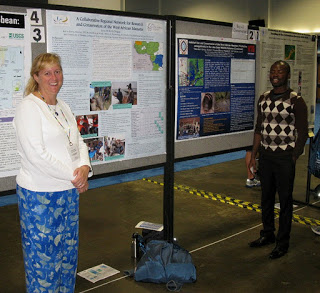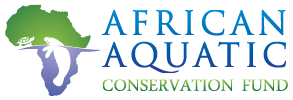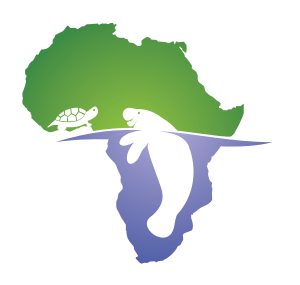Fall 2011 Recap
Happy New Year! Finally I have time to catch up with myself after a whirlwind Fall. I’m happy to report I survived my toughest semester of my PhD program, which will now make studying for and taking my qualifying exams this spring seem a like piece of cake 🙂 I learned alot in my Phylogenetics and Biochemistry clases that will help my research, but I’m also very glad they’re FINISHED!! In addition to school, there were a few other project achievements this Fall:
– My collaborator Katie Brill has aged the first 16 West African manatee earbones from samples I collected and imported from four countries. Earbones are used for aging because manatees lose and replace their teeth throughout their lives as they wear them out (think of a conveyor belt from the back of the jaw to the front… the teeth move forward as the ones in front of them wear down and fall out). This is the first time the aging technique (which requires slicing a very thin section of earbone with a diamond saw and counting the rings, just like in a tree) has been used for this species. The ages ranged from 12 to 39 years old (39 is very old for a wild manatee!) and this information will be used along with genetic samples collected from the same individuals to give us a picture of the lives of manatees in different populations. We continue to try to get more earbones from other countries, so we can expand our research; I also plan to use these and other bones to do stable isotope analyses to determine what the manatees eat. We’ll publish our results in a year or two, once we have more data.
Here’s a photo of a manatee earbone slice… how many rings can you count? The answer is at the bottom of this post. (Photo courtesy of Katie Brill)
 – In November I sponsored Cameroonian manatee researcher Aristide Kamla for 3 weeks of training in Florida. Aristide worked for almost a year to fundraise in order to make this trip, and in addition to the stipend I gave him (thanks to the generosity of my grants for training African researchers) he received a student travel award to attend the Society of Marine Mammalogy conference in Tampa (see below), and matched both awards with several thousand dollars of his own funds. My grants also allowed me to outfit Aristide with basic field equipment he needs for his manatee surveys in Cameroon, including binoculars, a GPS unit, a depth sounder with digital thermometer, a tape measure, a drybag to safely store his equipment, and manatee posters for educational outreach in his country. He’s an impressive and extremely motivated young man, and I’ll write more about his experiences in Florida in a separate post shortly.
– In November I sponsored Cameroonian manatee researcher Aristide Kamla for 3 weeks of training in Florida. Aristide worked for almost a year to fundraise in order to make this trip, and in addition to the stipend I gave him (thanks to the generosity of my grants for training African researchers) he received a student travel award to attend the Society of Marine Mammalogy conference in Tampa (see below), and matched both awards with several thousand dollars of his own funds. My grants also allowed me to outfit Aristide with basic field equipment he needs for his manatee surveys in Cameroon, including binoculars, a GPS unit, a depth sounder with digital thermometer, a tape measure, a drybag to safely store his equipment, and manatee posters for educational outreach in his country. He’s an impressive and extremely motivated young man, and I’ll write more about his experiences in Florida in a separate post shortly.
Aristide and me with some of his field equipment donated by this project
 – In late November I attended the biennial Society of Marine Mammalogy conference in Tampa, FL where I gave 3 presentations (1 oral and 2 posters) on different aspects of my ongoing research. The spoken presentation, “First Satellite Tagging of the West African Manatee” was given at the Sirenian Workshop and reported manatee rescues and satellite tagging I did in the Senegal River in 2009 in collaboration with Oceanium Dakar (a Senegalese NGO) and CBD-Habitat (a Spanish NGO). The two posters reported on my work to build the researcher network for the WA manatee (see below & link in menu at right), and a poster (lead author was Jonathan Perez Rivera) on our rehabilitation of Victor, the orphan manatee in Gabon.
– In late November I attended the biennial Society of Marine Mammalogy conference in Tampa, FL where I gave 3 presentations (1 oral and 2 posters) on different aspects of my ongoing research. The spoken presentation, “First Satellite Tagging of the West African Manatee” was given at the Sirenian Workshop and reported manatee rescues and satellite tagging I did in the Senegal River in 2009 in collaboration with Oceanium Dakar (a Senegalese NGO) and CBD-Habitat (a Spanish NGO). The two posters reported on my work to build the researcher network for the WA manatee (see below & link in menu at right), and a poster (lead author was Jonathan Perez Rivera) on our rehabilitation of Victor, the orphan manatee in Gabon.
Aristide and I presenting our posters at the marine mammal conference
 -The conference was also an excellent opportunity to meet with other researchers to discuss future collaborations, and I’m excited to report that Dr. Miriam Marmontel (who first developed the manatee earbone aging technique) will join Katie’s and my earbone research. I also met with a Mexican manatee researcher to discuss collaborating on manatee tooth wear (which helps us determine the types of plants they are eating) and with others to discuss WA manatee morphometrics (the study of manatee size and shape via measurements, which will help us determine if there are differences between populations in Africa) and future fundraising efforts. So all in all, it was a very successful meeting!
-The conference was also an excellent opportunity to meet with other researchers to discuss future collaborations, and I’m excited to report that Dr. Miriam Marmontel (who first developed the manatee earbone aging technique) will join Katie’s and my earbone research. I also met with a Mexican manatee researcher to discuss collaborating on manatee tooth wear (which helps us determine the types of plants they are eating) and with others to discuss WA manatee morphometrics (the study of manatee size and shape via measurements, which will help us determine if there are differences between populations in Africa) and future fundraising efforts. So all in all, it was a very successful meeting!
– In December the Columbus Zoo Conservation Fund awarded their 5th consecutive grant to this project, and I’m honored to have them as my longest term supporter of my West African manatee research! Thank you so much for your commitment to me and to this work Columbus Zoo!
So it was a very productive 4 months! Next up: aside from studying for 3 months for my qualifying exams and taking 2 more classes, I’ll sponsor Gambian manatee researcher Dawda Saine in Florida for training in February, I hope to finish and submit 2 manuscripts to scientific journals, and I’ll be planning my next field season in Africa (Senegal, and hopefully Guinea-Bissau and Gambia). And I’ll try to be better at posting news here more often! I wish you all a wonderful, healthy and happy 2012!!
Earbone age answer= 16 years

